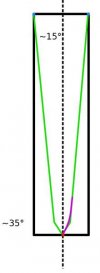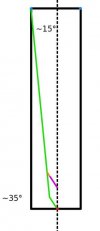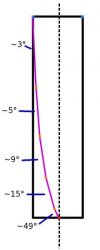In the following diagrams, the rectangle is the virgin bar stock, and the vertical dotted line is the central plane of the bar.
Here we have a full flat zero grind--the most irreducibly simplistic and uniform measurement for a knife ground from bar stock. No complicated curves to worry about, and the grind goes straight from one edge of the spine down to the centerline of the stock. Only a hollow grind could get thinner without reducing the spine thickness. Since truly hollow edges are nearly impossible for a typical user to preserve in their purest form, for all practical purposes, the approximately 7° angle shown here is the thinnest edge angle you can reasonably produce without thinning the spine.

Here we have a more conventional full flat grind with "V" or linear edge. The angles are exaggerated from what you would really typically see just for ease of viewing. On the right you see a convexed edge of equal effective angle. Note the volume of green that's been lopped off by this. A small reduction, but in practical use it's noticeable.

Here's a full flat grind in its original form and the bevel created by sharpening it waaaaaaaay back at the exact same angle. The fuchsia indicates the original length of the bevel--it was literally copy/pasted, shifted vertically, and color swapped. It's the exact same "piece" of bevel as the green original one. The orange represents the elongation of the visual bevel height cause by the sharpening. You can also see the massive reduction in primary bevel height.

This is a "polygonal" representation (again, with angles exaggerated so you can see it easier) that quasi-replicates a full convex grind. You could do all the math you wanted on this one since each section is a measurable volume of a rectangle with an inferable triangle pegged on the side. The effect is the same though--you can keep on taking shorter/thinner paths from the edge of the spine to the centerline until you hit the full flat zero grind of the original diagram again, and then start hollowing it out until you end up with nothing but a "T" that'll just crumple up on itself and not cut ANYTHING.


So all this argument is pretty academic. Thinner cuts easier, but it isn't as strong. Thicker is tougher, but has to displace more material over a shorter given unit of distance so it doesn't cut as well. Even if the aforementioned "T"-sectioned knife didn't crumple up (on account of being made out of "rostafrei"

) it'd just cut GREAT--practically falling through the target--until it hit the spine, and then it'd stop due to suddenly having to displace the full width of the spine over an incredibly mega-tiny distance.





